The cost of attending a U.S. college continues to rise and shows no sign of slowing down. Part of that expense is the hidden costs of college. If you haven’t budgeted for those costs, they can have a serious impact on your plans.
According to a report by Self.Inc, the average cost of college has risen 4.94% nationally since 2015[1]. That figure amounts to $1,344 more to study each year per student. The growth in education costs easily outpaced the U.S. inflation rate (now standing at 1.7% per U.S. government figures[2].
You probably know what tuition costs. You may be less aware of the rising “hidden costs” of attending college. This term covers a range of costs other than tuition. You expect to pay for food and lodging, but they may cost more than you planned to spend. Other expenses may come as a rude shock.
The Impact of Hidden Costs
Hidden costs affect student and family budgets. That impact is multiplied when the costs are unexpected.
- About 80% of college students say they have encountered an unexpected indirect college expense at least one time[3].
- 51% of college students surveyed paid more for indirect expenses than they expected, according to a 2020 study by uAspire, a college non-profit focused on college affordability[4].
- 53% “changed their food shopping or eating habits. 42% were concerned they wouldn’t be able to stay enrolled as a result,” according to the same report.
- uAspire surveyed over 800 colleges and universities and found that 39% “provided no estimates about non-tuition costs on their websites.” Laura Kean, a chief policy offer at uAspire and a co-author of the report, stated that “almost half of schools really didn’t give students the information they needed.”
👉 People familiar with the college experience are more likely to anticipate and budget for costs other than tuition. These costs often fall hardest on families sending a child off to college for the first time. These are also often the families who are least able to cover unexpected costs.
Getting a Grip on Hidden College Costs
Hidden charges can provide a severe case of sticker shock to beleaguered students and parents.
According to Mark Kantrowitz, a former publisher at SavingForCollege.com and author of the book, How to Appeal for More Financial Aid, most families do not plan for hidden college costs. “That’s because they’re not aware of them. Hidden college costs can increase the cost of a college education by $10,000 to $20,000 (approximately $300-to-$500 per month).”
College experts say that academic institutions don’t make it easy to find hidden costs. The uAspire report notes that colleges have 58 terms for describing indirect college expenses. Parents and students can also do a better job of rooting out hidden college costs from arcane tuition bills.
“I’m not sure if the costs are hidden, but rather most college families don’t ask or understand the questions they need to ask,” said Fred Amrein, co-founder of PayforED, a collegiate consulting firm located in Newtown Square, PA. “The emotional part of this decision often distorts the reality of cost. The colleges have gotten very good at making things very a la carte, such as the type of dorms, meal plans, and fees by major. They only give one year of financial information, so it is difficult to see the total cost and debt.”
“That means students and parents may be unable to see the financial consequence of their decisions,” Amrein said.
Knowledge is Power
The best path forward is exactly what colleges offer – education.
“The price many colleges list on their website or in their financial aid documents is often under-estimated,” said Laurie Kopp Weingarten, president of New Jersey-based One-Stop College Counseling. “Unfortunately every college seems to have their own method of calculating total costs which makes it difficult for families to compare their options when selecting where their student will enroll.”
What are the Hidden Costs?
Here are some of the most important hidden costs that you can expect to encounter. If you’re aware of the costs you can prepare for them and take action to reduce them. You could save thousands of dollars in the process.
Student Loan Interest
This cost usually doesn’t crop up until a parent or student inspects the financial aid package. It may appear even later when the student has left college. It may not hit you in college, but it can take a lot of the joy out of graduating.
“The biggest “hidden” costs are the thousands of dollars of interest that people are paying on their student loans,” said Jeffrey Scholnick, legal counsel at Silverman, Thompson in Baltimore, Md. “Many student loans will be accruing interest while the borrower is in college, but people don’t realize that as their payments don’t start until six months after they graduate when their debt has increased significantly.”
Scholnick, who specializes in helping individuals with onerous student loan debt, said that students and their parents need a loan repayment strategy before they start college. “Otherwise, they are shocked to see that their young graduates, earning entry-level salaries, are suddenly faced with loans equaling the amount of a mortgage,” he added.
Health Insurance
Many families are surprised to find out that they will need to pay for health insurance or some sort of additional healthcare fee”, Weingarten said.
Extra Dining Costs
Meals are a basic expense if you’re going away to college. You may not understand the full cost and the college may be in no hurry to explain it.
“Many colleges don’t cover all meals, or students decide not to purchase an unlimited meal plan, or their course schedule doesn’t allow them time for lunch/dinner in the dining hall,” Weingarten said. “Then, they also must purchase food.”
Students also often complain that they dislike the dining hall menu choices, so they “need” to purchase food/beverages. “It all adds up,” Weingarten added. “And don’t forget the socializing that goes on at restaurants and bars – that’s definitely not included in the cost of attendance.”
Textbooks
Buying textbooks for the semester up front may take a huge bite out of their hard-earned budget dollars. Many students don’t realize how much textbooks cost until it’s time to buy them. According to the college board, the average college student spent between $1,200 and $1,400 on textbooks during the 2018-2019 school year, a substantial bite that many families may not anticipate.
Dorm Furnishings
You expect to spend for sheets and blankets and some basic decorations. There may be other expenses as well. “Consider, for example, a common room in a suite that is completely unfurnished,” Weingarten noted. “When my son arrived at Princeton, we had to purchase a couch and chairs. Some of my students had the same situation at Yale. But at the University of Pennsylvania, where my daughter attended, the common rooms are furnished. It simply depends on the school policy.”
Social Costs
Social life is part of college life, and it often involves costs. Fraternity/sorority costs, club costs: fundraisers, dues, and end-of-semester events can all put a load on the budget.
“Hidden costs also include purchasing tickets to support your friends’ events,” Weingarten added. Some of these costs may be avoidable but it’s not reasonable to expect a college student to completely overlook the social side of life.
Loss of Merit Aid
“If a student loses their merit scholarship by not meeting the required grade-point average, it can turn into a true financial hardship for the family,” Weingarten said.
This happens more often than many parents expect. Students who are used to excelling in high school may not develop rigorous study habits. They can be overwhelmed by the workload and academic standards of a competitive university. When you’re used to being “the smart kid” it can be a shock to discover that now all the kids are smart. If you don’t adjust in time the cost impact could be severe.
COVID-Related Hidden College Costs
Mark Kantrowitz, a former publisher at SavingForCollege.com points to several hidden college costs stemming from the global COVID-19 pandemic, which may or may not go away. Covid-19 hidden college costs include:
General COVID-19 Fees
“Some colleges have added special Covid-19 fees to cover the cost of testing and free masks, and the cost of extra cleaning and plexiglass,” Kantrowitz said.
Remote Learning Costs
When a college switches to online-only education, the student may need to dig deep to learn remotely. “That could mean buying a new laptop computer, purchasing high-speed internet service for home, buying a desk and chair for use at home, and duplicating any disability-related accommodations,” he noted.
Apartment Rental
If a college tells students to vacate the dorms, the student may need to rent an apartment instead of returning home because they may be afraid of infecting elderly parents or grandparents. “If the student does return home, they may have to pay for extra plane, train or bus fare,” Kantrowitz said. “They may have to pay to ship or store their belongings.”
Is help on the way on COVID-related college costs? Not exactly.
According to Kantrowitz, Congress funded the Higher Education Emergency Relief Fund to help students out with COVID-related expenses. At least half of the fund must be provided to students as emergency financial aid grants for pandemic-related expenses. “This money often falls short of the actual need,” he said.
Colleges who kept tuition and room and board money and didn’t return it are under special scrutiny on un-imbursed costs. “When colleges required students to vacate the dorms in the spring of 2020, some refused to provide room and board refunds and most refused to provide tuition discounts even though online education lacks all of the benefits of in-person education,” Kantrowitz added.
Fight Back!
Some hidden costs are hard to cut, like food and accommodation. Parents and students can still trim many of those costs. Learning to live in a cost-conscious style can even be part of a student’s education. Experience with frugal living can be a big advantage after graduation!
“Unfortunately though, many hidden costs are hard to avoid,” Weingarten said. “Also, sometimes there are grants or reimbursements for costs that students don’t think to ask about. The more the student is aware of benefits and perks offered by the college, the better the chance that some expenses can be covered.”
College experts say you can cut your spending on hidden costs. These items are at the top of that list.
Use Your Meal Plan
“If you are required to purchase a meal plan, then use it, even if the food isn’t your favorite,” Weingarten said. “Try to take advantage of the free things offered to college students.” With meal plans as low as $800 per semester (i.e., four months or so), college students can save hundreds, if not thousands, of dollars by stocking to the meal plan and not eating out.
💡 Many colleges offer multiple meal plans. You may be able to save by choosing a plan that fits your eating style. Don’t pay for three full meals a day if you aren’t going to eat them!
Save on Textbooks
By purchasing used textbooks on eBay or Amazon or even renting them on textbook sales platforms like Chegg, college students can save up to 50% off the cost of collegiate textbooks. Look into second-hand books sold at your university by students who have already taken the course. Some textbooks may be available in e-book format, which can reduce both cost and the weight of a school bag.
💡 Remember that students can sell their textbooks when the semester is over and recoup some of their textbook expenditures.
Off Campus Local Costs
Make sure to ask for a student discount when purchasing items off-campus. “Many retailers offer discounts if you present a student I.D.,” Weingarten noted. Student I.D.’s can save the average college student about 40% for movies and entertainment, 40% off travel and hotels, and about 20% off for digital hardware like laptop computers, among other savings.
Curb Parking Tickets
If you have a vehicle on campus, avoid parking in areas where you can get a ticket. “While one or two might not be that much of a problem, if you add them up over the months and years that you’re at college, it can turn out to be quite a hefty cost,” said George Birrell, founder of TaxHub, a New York City-based tax planning firm. “Learn your lesson quickly and don’t park in high-risk ticker areas. Uber is a good option against campus parking issues, too.”
☝️ Parking tickets can start low, depending on where the college is located. An initial ticket can $10 in rural areas and $40 in urban areas. If you ignore the ticket, the cost may go up. That could mean hundreds of dollars in savings by avoiding parking tickets.
Assess General Tuition Costs
Before choosing a college, calculate an estimate of the hidden college costs, so you can budget for them. “Review all of the fees listed on the college’s website,” Kantrowitz said. “Choose a cheaper college, taking into account the hidden costs. Identify the hidden college costs you can avoid or reduce. Then, plan a path from enrollment to graduation, so you can graduate on time.”
☝️ By choosing a less expensive college, a student can save over $10,000 annually – and up. Getting a grip on college fees can save a family and student hundreds of dollars annually.
Consider Studying Close to Home
Living away from home may be closer to the college experience you’re looking for, but it can push the costs of college up. If you live near a college or community college, starting out in a local school and living at home can cut your costs by a substantial margin. You can always transfer to the school you want if you’re local school doesn’t offer the degree you want or you feel that you’d gain a significant advantage from graduating from a better-known school.
☝️ Studying at a local college may push your transportation costs up. You’ll need to consider that when you compare costs, but the savings on accommodation and food will be substantial.
The Takeaway on Hidden College Costs
Why do colleges get away with hiding costs, or with being less than open about non-tuition expenses? Because they can.
“I have no idea why colleges can’t more accurately estimate the costs and why they can’t curtail some of them,” Weingarten said. “For example, some colleges offer free laundry and/or free printing. Others charge for one or the other while many allocate a specific dollar amount of free services.”
The bottom line is simple and straightforward.
“Do as much research as you can before committing to a college,” Weingarten said. “Try to identify what the unexpected costs and estimate how much they can cost each year. As a family, discuss what expenses are reasonable and what the student should prioritize.”











